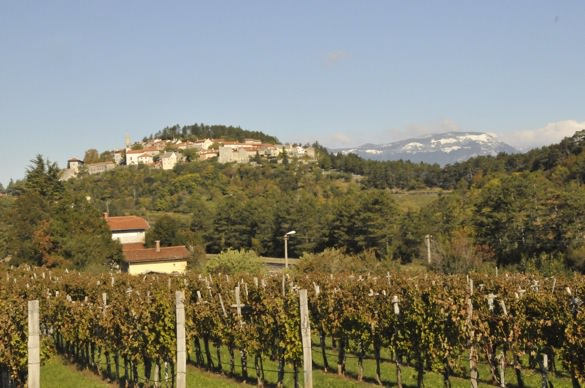“My soul is jolly/As though it had been drinking the Karst teran,” wrote poet Oton Župancic. A karst is a landscape characterized by eroded limestone formations, and the word is derived from Slovenia’s Karst region. Located in southwest Slovenia, the Karst region, which runs alongside the Italian city of Trieste, is an uncommon mixture of rolling hills and deep valleys with patches of limestone shining through like bone. Throw in caves, underground rivers, disappearing lakes, wineries, and kraški pršut (Karst prosciutto), and a road trip through the Karst region is full of possibilities.
I picked up my rental car in Piran, a coastal village on Slovenia’s 29-mile coast. The sun was shining on the waves of the Adriatic Sea, and I drove northeast toward the hilltop town of Štanjel.
Driving in Slovenia is a breeze because the roads are very good and drivers don’t have to stop for tolls. If you rent a car in Slovenia, it will most likely come with a vignette sticker, which is required by law in Slovenia and which allows you to blow through most toll booths. If you rent a car elsewhere, make sure to purchase a vignette sticker at a gas station before crossing the border.
Getting off the highway onto the local 446 roadway, I was immediately in the middle of nowhere. The snow-capped Alps dominated the horizon to the north, and on either side of the road were vineyards interspersed with pine and oak groves. Every ten minutes I passed a sign advertising teran, the local wine made from the refošk grape. The wineries looked no different than the stone houses, known as borja?, that comprise the villages. To go wine tasting, all you have to do is knock on doors until you find someone at home.
I passed through the towns of Sežana, Sepulje, and Tomaj, and the road got suddenly smaller; then it turned to dirt. I passed a man herding a few sheep, then a couple of elderly ladies who were bent down in a field foraging or picking flowers. Slovenia is a very advanced country, but this part of the Karst region could have been in the middle ages.
After turning on the GPS, I soon arrived in Štanjel. Štanjel is a hilltop village crowned with a small castle that has been caught in almost every major European war since the 17th century. It was subject to repeated attacks during the Ottoman Wars in the 17th century. A graveyard lies at the base of the town, where an uncountable number of Turkish soldiers lie buried. Štanjel was also on the front line between the Allies and the Germans during WWII. Today, the Ferrari Gardens wrap up the sleepy town in a blanket of pine, persimmon, and oak trees. I took the path from the base of the hill and wound my way up to the top. There, I found stunning views of the surrounding karst. At the beginning of the 20th century, the land was completely deforested, and trees have only recently returned. Patches of prickly textured limestone stuck out here and there.
When visiting the town of Štanjel, I highly recommend stopping in Galerija Lojzeta Spacala—an art gallery featuring the work of accomplished local artist, Lojze Spacal.
Next, I drove to the town of Komen, which is famous for producing kraški pršut, or Karst prosciutto. Served in thin, crimson slices, pršut pairs perfectly with the area’s sheep and goat cheeses. Karst gastronomy is reminiscent of Austrian and Italian cuisines, featuring such dishes as jota (a sauerkraut, bean, and turnip soup), mlinci and lezanji (two types of homemade pasta), and potatoes in zevenca (a sauce of sauerkraut and Karst sausage).
I began my second day in the Karst region by getting completely lost and driving in and out of Italy and Slovenia repeatedly. Fortunately, the border between Italy and Slovenia is open, and travelers may freely drive in and out as many times as they want (which for me, seemed to be about twenty). I drove to the Škocjan Caves near the town of Divaca. The Karst region is famous for its elaborate cave systems, including the Postojna Caves and the disappearing lake (Cerknica Lake), which supplies fishing and boating activities in the spring and sinks underground in the fall.
The Škocjan Caves are home to the largest underground canyon in Europe, and I took a guided tour (the only kind of tour offered) that lasted about two hours. Inside the massive caves, I found hundreds of stalactites and stalagmites as well as coral-like rock formations. Toward the end of the tour, I began to hear the sound of rushing water, and soon we stood on the edge of a massive canyon with a rushing river at the bottom. A path was carved into one side of the cave wall. As I walked along, the only thing between me and a 246-foot fall was a seemingly inadequate metal railing. A bridge crossed the canyon, and our guide pointed out cams where the original spelunkers had navigated the sheer walls. An elevator took us back to the beginning, where there were magnificent views of the surrounding countryside.
This was the last stop on my Karst road trip, and I drove back to Piran at 80 miles an hour, which just happens to be the speed limit on the largest highways.
Written by Mattie Bamman for EuropeUpClose.com






Marilyn
Tuesday 14th of August 2012
I knew almost nothing about this region, but now I'm fascinated. Thanks.